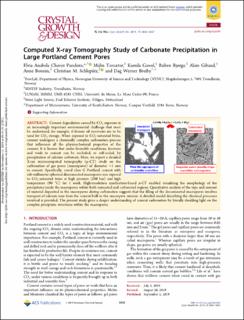| dc.contributor.author | Chavez Panduro, Elvia Anabela | |
| dc.contributor.author | Torsæter, Malin | |
| dc.contributor.author | Gawel, Kamila | |
| dc.contributor.author | Bjørge, Ruben | |
| dc.contributor.author | Gibaud, Alain | |
| dc.contributor.author | Bonnin, Anne | |
| dc.contributor.author | Schlepütz, Christian M. | |
| dc.contributor.author | Breiby, Dag Werner | |
| dc.date.accessioned | 2020-05-07T09:14:15Z | |
| dc.date.available | 2020-05-07T09:14:15Z | |
| dc.date.created | 2019-09-13T09:34:44Z | |
| dc.date.issued | 2019 | |
| dc.identifier.citation | Crystal Growth & Design. 2019, 19 (10), 5850-5857. | en_US |
| dc.identifier.issn | 1528-7483 | |
| dc.identifier.uri | https://hdl.handle.net/11250/2653592 | |
| dc.description.abstract | Cement degradation caused by CO2 exposure is an increasingly important environmental challenge that must be understood, for example, if former oil reservoirs are to be used for CO2 storage. When exposed to CO2-saturated brine, cement undergoes a chemically complex carbonation process that influences all the physicochemical properties of the cement. It is known that under favorable conditions, fractures and voids in cement can be occluded, or self-sealed, by precipitation of calcium carbonate. Here, we report a detailed X-ray microcomputed tomography (μ-CT) study on the carbonation of gas pores (macropores) of diameter ∼1 mm in cement. Specifically, cured class G Portland cement with sub-millimeter spherical disconnected macropores was exposed to CO2-saturated brine at high pressure (280 bar) and high temperature (90 °C) for 1 week. High-resolution synchrotron-based μ-CT enabled visualizing the morphology of the precipitates inside the macropores within both unreacted and carbonated regions. Quantitative analysis of the type and amount of material deposited in the macropores during carbonation suggests that the filling of the disconnected macropores involves transport of calcium ions from the cement bulk to the macropore interior. A detailed model describing the chemical processes involved is provided. The present study gives a deeper understanding of cement carbonation by literally shedding light on the complex precipitate structures within the macropores. | en_US |
| dc.language.iso | eng | en_US |
| dc.publisher | American Chemical Society | en_US |
| dc.subject | Calcium | en_US |
| dc.subject | Ions | en_US |
| dc.subject | Depositions | en_US |
| dc.title | Computed X-ray Tomography Study of Carbonate Precipitation in Large Portland Cement Pores | en_US |
| dc.type | Journal article | en_US |
| dc.type | Peer reviewed | en_US |
| dc.description.version | publishedVersion | en_US |
| dc.rights.holder | This is an open access article published under an ACS AuthorChoice License, which permits
copying and redistribution of the article or any adaptations for non-commercial purposes. | en_US |
| dc.source.pagenumber | 5850-5857 | en_US |
| dc.source.volume | 19 | en_US |
| dc.source.journal | Crystal Growth & Design | en_US |
| dc.source.issue | 10 | en_US |
| dc.identifier.doi | 10.1021/acs.cgd.9b00864 | |
| dc.identifier.cristin | 1724343 | |
| dc.relation.project | Norges forskningsråd: 193816 | en_US |
| dc.relation.project | Norges forskningsråd: 275182 | en_US |
| dc.relation.project | Norges forskningsråd: 262644 | en_US |
| dc.relation.project | Norges forskningsråd: 243765 | en_US |
| cristin.unitcode | 7401,80,7,0 | |
| cristin.unitcode | 7401,80,64,0 | |
| cristin.unitname | Petroleum | |
| cristin.unitname | Materialer og nanoteknologi | |
| cristin.ispublished | true | |
| cristin.fulltext | original | |
| cristin.qualitycode | 2 | |
